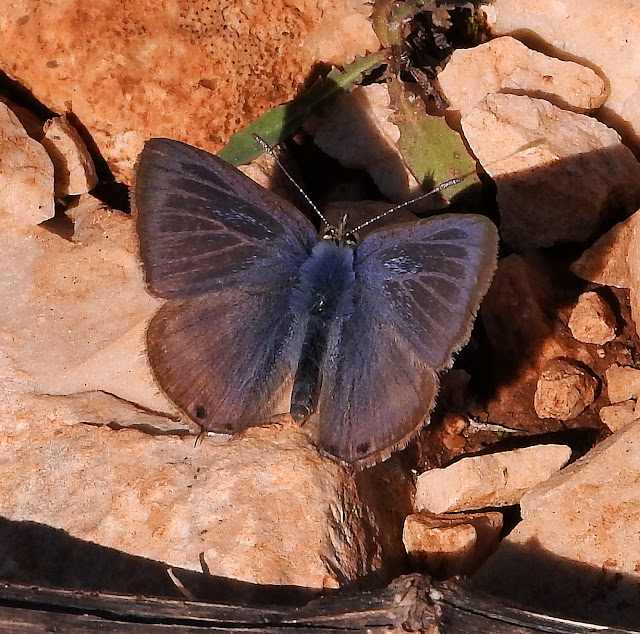This Blog contains Wildlife and Bird Photos from Walks, Safaris, Birding Trips and Vacations. Most of the pictures have been taken with my Nikon P900 and P950X cameras. On the right of the page are labels for each species of Bird/Animal etc. Click on a label and it will show all of the photos taken for that species. I am adding as much information for each species as I can from sources Wikipedia. To see any pictures at full size just click on the picture.
TOTAL PAGEVIEWS
TRANSLATE
Wednesday 23 February 2022
Tuesday 22 February 2022
Monday 21 February 2022
6-4-2019 LINYANTI, BOTSWANA - ZAMBESI CRESTED BARBET (Trachyphonus vaillantii ssp. nobilis)
The crested barbet (Trachyphonus vaillantii) ('trachys'=rough, 'phone'=voice, sound') is a sub-Saharan bird in the Lybiidae family. Its specific name commemorates François Levaillant, a famed French naturalist.
With its thick bill and very colourful plumage the crested barbet is unmistakable. This small bird has a speckled yellow and red face with a small black crest. The belly is yellow with red speckles, wings are black with white specks and it has a broad black band on its neck. Yellow head and body with black and white feathers, red markings on end of body, its colour blends well in the bush. They have a distinct trill.
21-2-2022 PINET, VALENCIA - COMMON BRIMSTONE BUTTERFLY (Gonepteryx rhamni)
Gonepteryx cleopatra, the Cleopatra or Cleopatra butterfly, is a medium-sized butterfly of the family Pieridae.
Gonepteryx cleopatra is a medium-sized butterfly with a wingspan of about 50–70 mm (2.0–2.8 in). It is a sexually dimorphic species; the female has pale yellow or greenish wings, whereas the male is darker yellow with an orange patch on the forewing. Both sexes have a forewing apical hook and brown dots in the center of each wing, and the underside of wings is light greenish yellow. The greenish color, the shape and the pronounced venation on the hindwings give to these butterflies a good camouflage, making them resemble just leaves.
Sunday 20 February 2022
4-6-2019 LINYANTI CAMP, BOTSWANA - AFRICAN HAWK EAGLE (Aquila spilogaster)
The African hawk-eagle (Aquila spilogaster) is a large bird of prey. Like all eagles, it belongs to the family Accipitridae. This species’ feathered legs mark it as a member of the Aquilinae subfamily. The African hawk-eagle breeds in tropical Sub-Saharan Africa. It is a bird of assorted woodland, including both savanna and hilly areas but the tend to occur in woodland that is typically dry. The species tends to be rare in areas where their preferred habitat type is absent. This species builds a stick nest of around 1 m (3.3 ft) across in a large tree. The clutch is generally one or two eggs. The African hawk-eagle is powerfully built and hunts small to medium sized mammals and birds predominantly, occasionally taking reptiles and other prey as well. The call is a shrill kluu-kluu-kluu. The African hawk-eagle is considered a fairly stable species and a species of Least Concern per the IUCN.
The African hawk-eagle is uncommonly aggressive and bold predator. Their primary hunting tool is their powerful feet. In general, their sneaky foraging techniques recall a huge Accipiter. In terms of agility and hunting prowess, especially in terms of their short-distance flight after prey, they are also somewhat reminiscent of an Accipiter. Mostly the African hawk-eagle engages in still-hunting, wherein they scan from prey from an inconspicuous perch for a long period. When prey is spotted, the hawk-eagle engages in a low level dash from their perch in cover. They often uses cover to cloak their approach almost up the point where they strike. While it has been claimed that their flight is “silent”, it would presumably be more correct to say that the hunting hawk-eagle engages in minimal flapping flight so as to not alert prey to their approach. Often, the hawk-eagles wait near prey-concentrated areas, such as waterholes and among riparian trees for birds to come to drink or by clearings that birds frequently cross. African hawk-eagles may too quarter above the ground and seize any prey they surprise. They are capable of sometimes taking birds on the wing but usually prefer to catch them on the ground and may force avian prey intercepted in the air back to the ground. Often terrestrial birds are taken right around the moment they alight. In some instances, prey may be chased, even on foot, into thickets. African hawk-eagles have seldom been recording engaging a stoop from soaring flight to capture prey. Pairs of African hawk-eagles often hunt together and in these circumstances seem to engage in deliberate cooperation, one distracting, the other striking. They share this tendency for hunting in pairs with their sister species, the Bonelli's eagle, which has been implied to engage in tandem hunts possibly for sociosexual pairing reasons rather than for obtaining larger or more difficult prey, as is typically assumed of tandem-hunting raptors. One tandem hunting pair of African hawk-eagles appeared to remarkably make use of a mesh fence to drive guineafowl into in a cunning strategy to prevent their escape. Yet another pair of African hawk-eagles appears to derive much of its prey by regularly and opportunistically perching in a tree holding a fruit bat colony.
Saturday 19 February 2022
Subscribe to:
Posts (Atom)

















































